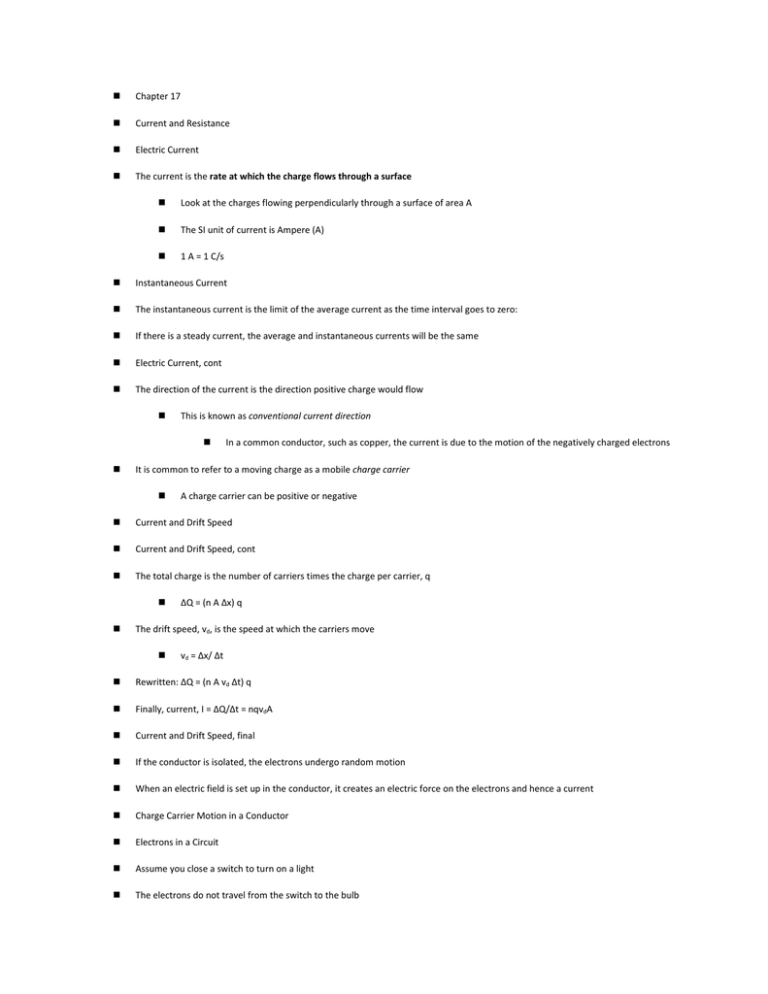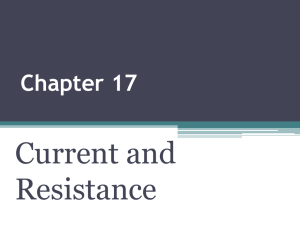Ch 17 notes - Geneva Area City Schools
advertisement

Chapter 17 Current and Resistance Electric Current The current is the rate at which the charge flows through a surface Look at the charges flowing perpendicularly through a surface of area A The SI unit of current is Ampere (A) 1 A = 1 C/s Instantaneous Current The instantaneous current is the limit of the average current as the time interval goes to zero: If there is a steady current, the average and instantaneous currents will be the same Electric Current, cont The direction of the current is the direction positive charge would flow This is known as conventional current direction In a common conductor, such as copper, the current is due to the motion of the negatively charged electrons It is common to refer to a moving charge as a mobile charge carrier A charge carrier can be positive or negative Current and Drift Speed Current and Drift Speed, cont The total charge is the number of carriers times the charge per carrier, q ΔQ = (n A Δx) q The drift speed, vd, is the speed at which the carriers move vd = Δx/ Δt Rewritten: ΔQ = (n A vd Δt) q Finally, current, I = ΔQ/Δt = nqvdA Current and Drift Speed, final If the conductor is isolated, the electrons undergo random motion When an electric field is set up in the conductor, it creates an electric force on the electrons and hence a current Charge Carrier Motion in a Conductor Electrons in a Circuit Assume you close a switch to turn on a light The electrons do not travel from the switch to the bulb The electrons already in the bulb move in response to the electric field set up in the completed circuit A battery in a circuit supplies energy (not charges) to the circuit Electrons in a Circuit, cont The drift speed is much smaller than the average speed between collisions When a circuit is completed, the electric field travels with a speed close to the speed of light Although the drift speed is on the order of 10-4 m/s, the effect of the electric field is felt on the order of 108 m/s Circuits A circuit is a closed path of some sort around which current circulates A circuit diagram can be used to represent the circuit Quantities of interest are generally current and potential difference Meters in a Circuit – Ammeter An ammeter is used to measure current In line with the bulb, all the charge passing through the bulb also must pass through the meter Meters in a Circuit – Voltmeter A voltmeter is used to measure voltage (potential difference) Connects to the two contacts of the bulb Resistance In a conductor, the voltage applied across the ends of the conductor is proportional to the current through the conductor The constant of proportionality is the resistance of the conductor Resistance, cont Units of resistance are ohms (Ω) 1Ω=1V/A Resistance in a circuit arises due to collisions between the electrons carrying the current with the fixed atoms inside the conductor Georg Simon Ohm Ohm’s Law Experiments show that for many materials, including most metals, the resistance remains constant over a wide range of applied voltages or currents This statement has become known as Ohm’s Law ΔV = I R Ohm’s Law is an empirical relationship that is valid only for certain materials Materials that obey Ohm’s Law are said to be ohmic Ohm’s Law, cont Ohm’s Law, final Resistivity The resistance of an ohmic conductor is proportional to its length, L, and inversely proportional to its cross-sectional area, A ρ is the constant of proportionality and is called the resistivity of the material See table 17.1 Temperature Variation of Resistivity For most metals, resistivity increases with increasing temperature With a higher temperature, the metal’s constituent atoms vibrate with increasing amplitude The electrons find it more difficult to pass through the atoms Temperature Variation of Resistivity, cont For most metals, resistivity increases approximately linearly with temperature over a limited temperature range ρ is the resistivity at some temperature T ρo is the resistivity at some reference temperature To To is usually taken to be 20° C is the temperature coefficient of resistivity Temperature Variation of Resistance Since the resistance of a conductor with uniform cross sectional area is proportional to the resistivity, you can find the effect of temperature on resistance Electrical Energy in a Circuit In a circuit, as a charge moves through the battery, the electrical potential energy of the system is increased by ΔQΔV The chemical potential energy of the battery decreases by the same amount As the charge moves through a resistor, it loses this potential energy during collisions with atoms in the resistor The temperature of the resistor will increase Energy Transfer in the Circuit Energy Transfer in the Circuit, cont Point A is the reference point As the charge moves through the battery from A to B, the potential energy of the system increases by DQDV It is grounded and its potential is taken to be zero The chemical energy of the battery decreases by the same amount Energy Transfer in the Circuit, final As the charge moves through the resistor, from C to D, it loses energy in collisions with the atoms of the resistor The energy is transferred to internal energy When the charge returns to A, the net result is that some chemical energy of the battery has been delivered to the resistor and caused its temperature to rise Electrical Energy and Power, cont The rate at which the energy is lost is the power From Ohm’s Law, alternate forms of power are Electrical Energy and Power, final The SI unit of power is Watt (W) I must be in Amperes, R in ohms and DV in Volts The unit of energy used by electric companies is the kilowatt-hour This is defined in terms of the unit of power and the amount of time it is supplied 1 kWh = 3.60 x 106 J Superconductors Superconductors, cont The value of TC is sensitive to Chemical composition Pressure Crystalline structure Once a current is set up in a superconductor, it persists without any applied voltage Since R = 0 Superconductor Timeline 1911 Superconductivity discovered by H. Kamerlingh Onnes High temperature superconductivity discovered by Bednorz and Müller Superconductivity near 30 K Superconductivity at 96 K and 105 K 1986 1987 Current Superconductivity at 150 K More materials and more applications Superconductor, final Electrical Activity in the Heart Operation of the Heart The sinoatrial (SA) node initiates the heartbeat The electrical impulses cause the right and left artial muscles to contract When the impulse reaches the atrioventricular (AV) node, the muscles of the atria begin to relax The ventricles relax and the cycle repeats Electrocardiogram (EKG) Abnormal EKG, 1 Abnormal EKG, 2 Abnormal EKG, 3 Implanted Cardioverter Defibrillator (ICD) Functions of an ICD Monitor atrial and ventricular chambers Differentiate between arrhythmias Store heart signals for read out by a physician Easily reprogrammed by an external magnet More Functions of an ICD Perform signal analysis and comparison Supply repetitive pacing signals to speed up or show down a malfunctioning heart Adjust the number of pacing pulses per minute to match patient’s activity






